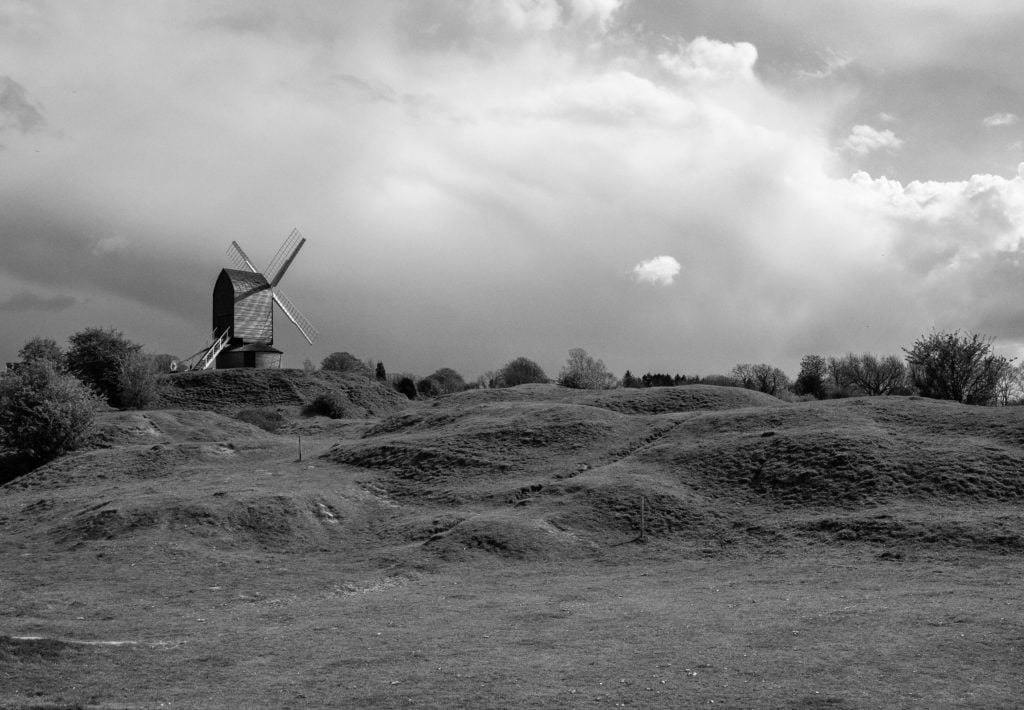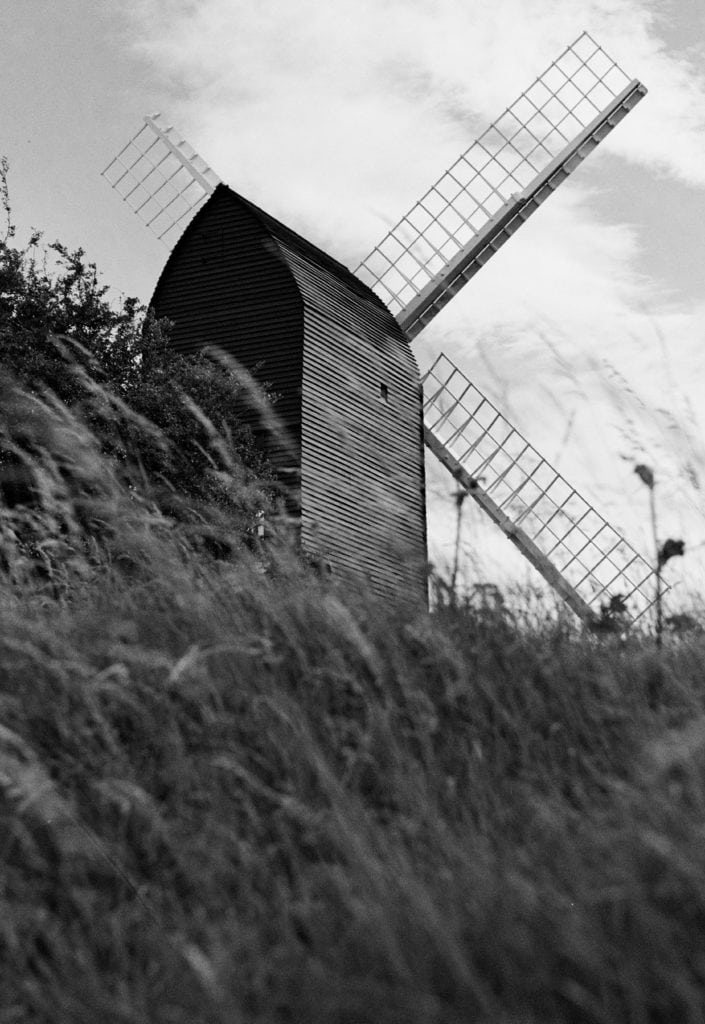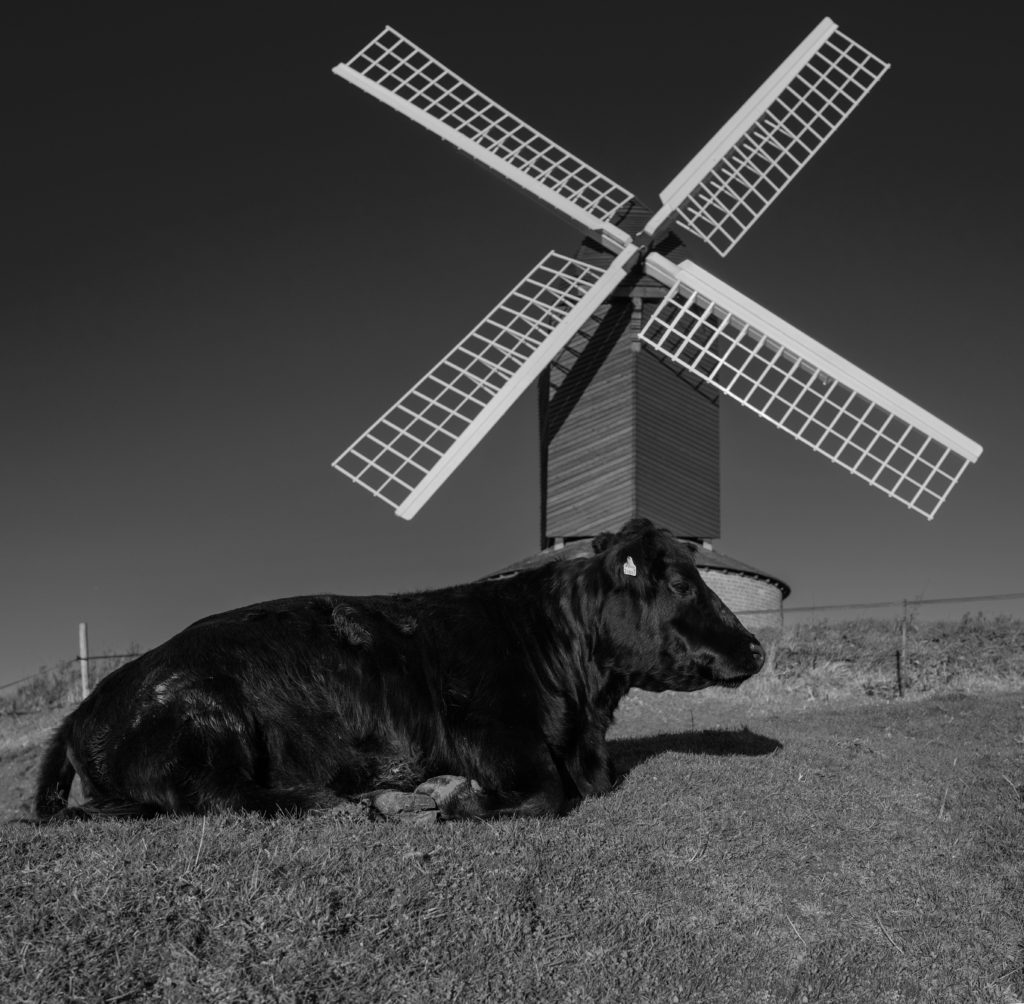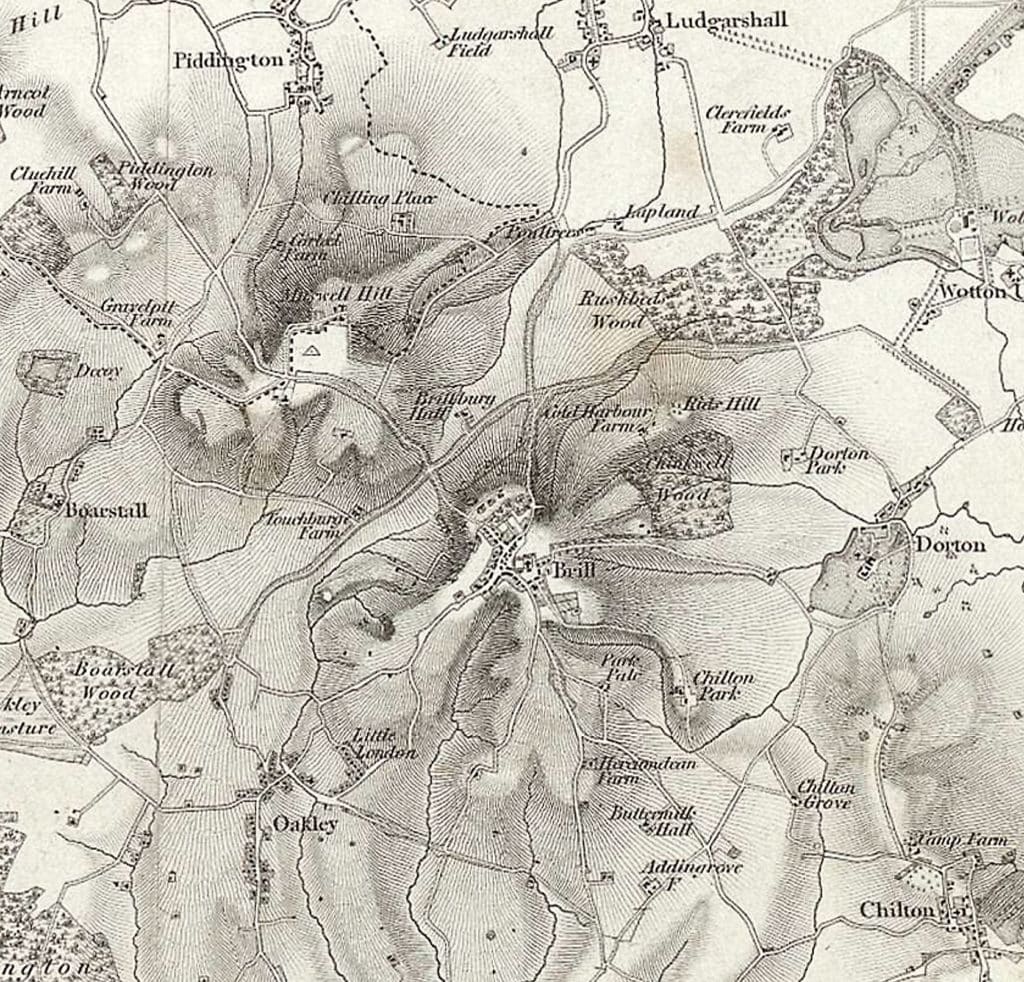
Brill windmill is well known to photographers all over Oxfordshire and Buckinghamshire; the hill-top site is also a popular spot for walkers, cyclists and picnickers. To reach the village of Brill requires a climb up a steep hill about 4 miles from Long Crendon and 7 miles from Bicester. At 190 metres above sea level, it’s the highest vantage point for miles around and provides excellent views over the Vale of Aylesbury below. Brill windmill and the the undulating rough ground where the clay was once worked make it a unique spot. On a windy day it’s an ideal location for long exposure shooting and sunsets from Brill Hill make for a popular spectacle. You can find a gallery of my black and white pictures of Brill here.
Brill – A Rich History
Edward the Confessor had a hunting-lodge adjacent to it; Henry II. kept his court here in 1160, attended by Becket, and again in 1162; King John spent his Christmas here in 1205; Henry III. held his court here in 1224; and Sir G. Gerard, under Charles I., placed a force here in 1642, and repelled an attack by Hampden. The parish comprises 2,600 acres. Real property, £5,873. Pop., 1,432. Houses, 324. The property is much subdivided. The manor was given by the Conqueror to Nigel the huntsman, and has descended from him to Sir T. D. Aubrey, Bart. Stone is quarried; yellow ochre is found; and clay has been worked into pottery here since the time of the Romans, but ceases to be in request. A chalybeate spring in the immediate neighbourhood of the village has some medicinal repute; and a hotel stands adjacent to it for the accommodation of visitors. A grove near the village is probably a relic of Bernwood forest.
John Marius Wilson’s Imperial Gazetteer of England and Wales, 1870-72

Brill Landscape
“There are fine exhilarating, panoramic views out from the hills. Several large farms are situated on prominent areas of the steep hillsides one of the most notable is Chilton Park. The common land, unimproved grassland and other patches of rough ground add to the sense of a landscape with strong historic associations, which has been left relatively unchanged for centuries.” This fine description of the landscape around Brill is from the Aylesbury Vale Landscape Character Assessment, but the views are so good, it barely does the place justice.
Village Origins
The combination of its hilltop location, good soil and the presence of springs have made Brill an attractive location from the earliest times and it has been occupied since the Iron Age. Even the origin of the name of the village is ancient as it includes both the Anglo-Saxon and Celtic words for hill (Bre-hyll). Surviving Celtic place names are less common in the South of England than they are further North. In the reign of Edward the Confessor the village was known as Bruhella.

Clay, Pottery and Bricks
Brill is best known for its old post-mill and the clay pits that were dug for the production of pottery and Brill bricks. The clay pits were in use from Roman times until the last bricks were produced in the 1920s, which is also when the windmill closed as a business. Many of the older houses in the village are built of Brill bricks, as are Thame Grammar School and Waddesdon Manor.
Royal Manor
Brill was a Royal Manor of the kings of Wessex in the Anglo-Saxon period as it lay in the heart of the royal forest of Bernwood. There was a Royal Hunting Lodge there, sometimes referred to as a Royal Palace. Edward the Confessor, Henry II and Henry III stayed there in the 12-13th centuries.
The Civil War and the Battle of Brill
The Royal Lodge at Woodstock became a palace under Henry II, who spent time here with his mistress, Rosamund Clifford, after which Brill became less important; by 1337 it had ceased to be a Royal Manor. It is possible there was a castle at Brill as a map of 1591 has “Castell Hill” marked but this is apparently the only evidence of such a fortification.
Medieval Brill
By the middle of the 13th century Brill had a market and annual fair, but it did not develop into a town, possibly due to competition from the larger markets of Aylesbury or Long Crendon. Brill’s principal industry was pottery which was sold at markets in Oxford surrounding areas. Brick and tile making took over from pottery after the medieval period.
Brill saw action during the English Civil War. A royalist force occupied the village as part of a defensive ring of the city of Oxford where Charles had consolidated his forces. There was an abortive Parliamentarian attack by the Parliamentary commander-in-chief of Buckinghamshire Colonel Goodwin in January 1643 (known as the Battle of Brill). Shortly afterwards Brill was replaced by nearby Boarstall as a garrison and Royalist troops left the following year.

The Spa at Dorton
Nearly two hundred years later the proprietor of the nearby Dorton estate, Mr Ricketts, attempted to turn Brill into a spa town. The mineral spring at Dorton was renowned for its curative qualities and Ricketts opened the spa in 1830. A Grand Fête was held in 1837 and for a short while the resort was fashionable. It consisted of a classical spa building with pump room and baths set in an ornamental pleasure ground. This was reached from an associated hotel in Brill – the Spa Hotel. The drive between the two survives as a public footpath. Tunbridge Wells and Leamington Spa secured Royal patronage for their Spas whilst the rather remote Dorton/Brill business dwindled and closed in the late nineteenth century. The Spa Hotel was pulled down after it sustained damage from a German doodle-bug in World War II.
Brill Tramway
In 1868 the Aylesbury and Buckingham Railway was completed and the Duke of Buckingham built a light railway to provide freight access by rail to his estates. An extension to Brill known as the Brill Tramway gave access to a brickworks there, which was followed by passenger facilities in 1872. The Metropolitan Railway took over the line in 1896 and the branch line survived until 1935
A good deal of old Brill survives today; 54 of the village’s buildings are currently listed. The earliest of these is All Saints Church, originally a private chapel whose earliest features date from the 12th century.
Brill Windmill
The rectory manor of Brill had a mill in 1086. This mill would have been water or animal driven as windmills appeared a century or so later. The post mill, which could be turned into the wind is named after the large upright post which the mill’s main structure is balanced on, enabling the mill is to rotate to face the direction of the wind. The high ground at Brill is an ideal location for a post mill. According to the History of the County of Buckingham “a windmill was built here of timber from Bernwood Forest, probably on the site on which John de Moleyns, about 1345, constructed another with oaks felled in his demesne woods.”
Brill windmill in its current form has been dendro dated to 1686 and survived as a working business until 1924 when it finally closed. A roofed wall, or roundhouse, was built around the bottom part of the post in 1864. It was removed in the 1930s in poor condition and rebuilt in 1950 using bricks from a kiln that had been demolished when the last of Brill’s many brick and tile yards closed. It was last restored again in 2009. The mill was purchased by Sir Henry Aubrey-Fletcher in 1929 to save it from destruction, and was maintained by trustees until taken over by Buckingham County Council in 1947.
A second post-mill once stood on Brill Common. Parson’s Mill was built in 1634 and stood on the opposite side of the road to the current mill. It was struck by lightning in 1905 and demolished soon afterwards.

The Community Herd
There is a small community herd of Dexter cattle that conservation graze the common in small temporary paddocks. These are moved at intervals to avoid overgrazing. I was interested to learn that Dexters are the smallest native breed of cattle in the British Isles and are both docile and hardy. Being so small, they have no trouble at all with the steep slopes of the common. You can track where they are being grazed at the community herd website.
Visiting Brill Windmill
Brill is located near the A41 at South Hills, Brill, Aylesbury HP18 9TQ. From the North and Bicester, take the B4011, leaving the B road on a tight right-hand turn. Follow the narrow road (watch out for cyclists) and the windmill will be on your right. From the South and Thame take the B4011. There is are a couple of exits that lead to Brill. If you end up in the village centre, head for Windmill Street. The windmill will be on the left as you exit Windmill Street. There is a small car park next to the windmill.
To go inside the windmill you need to go at specified times during which the windmill is opened up by volunteers, which is managed by volunteers. The windmill is open for these visits on Sunday afternoons, 2-5pm from Easter to September. Tickets costs £3 for adults and £1 for children. More details can be found and out of hours visits arranged by visiting the Brill Windmill website.
There is a circular walk that starts by the windmill and descends the hill to walk towards Ludgershall, Piddington and Boarstall.
If you can’t get to Brill there is some drone footage on YouTube from 2015 and 2021 that provides good aerial vie of the windmill and the common.
Pubs Near Brill Windmill
There are two pubs in Brill. The Pheasant is located next door at 39 Windmill Street, HP18 9TG and offers outside seating with views of the windmill. The Pointer is in the village centre at 27 Church Street HP18 9RT and is supplied by their own butchers, which is just next door. A little further out is the The Chandos Arms at 8 The Turnpike, HP189QB in nearby Oakley.
Brill Dog Walking
Brill common is popular with dog walkers and both The Pheasant and The Pointer are dog friendly.
People, Books and TV References
There are several notable people as well as books and TV related to the village, the most interesting of which I’ve included here:

- J. R. R. Tolkien used the name and various other features of Brill as the basis for the village of Bree in The Lord of the Rings.
- Edward Lear, best known for “The Owl and the Pussy-cat” refers to Brill in More Nonsense Pictures, Rhymes, Botany, etc.
- Brill makes an appearance seen in two episodes of Midsomer Murders: A Tale of Two Hamlets and The Wolf Hunter of Little Worthy
- The Great Train Robbers hid at the remote Leatherslade Farm on Brill’s boundary with the village of Oakley In 1963.
- Martyr Thomas Belson was born in the village circa 1560. He was found guilty of assisting Roman Catholic priests, and was executed in Oxford in 1589.
- Sir John Betjeman rejoiced that the long arm of ‘Metro-land’ was halted before impinging on “the remote hilltop village of Brill”
More of Brill Windmill
Today Brill windmill is one of the oldest and best preserved in Britain. The steps that extend up to the doors at the rear of the mill are a very popular spot for group photos, whilst small children love to run around the roundhouse. I’ve enjoyed many a great picnic at Brill with my daughters, both of whom are as fond of the place as I am.
I have been taking photographs around Brill for some years with film and digital cameras, sometimes making use of specialist tilt-shift lenses and taking long exposures taken with a dark filter on a tripod. You can view a gallery of my black and white pictures of Brill here.
Sources
I found The Buckinghamshire Historic Towns Assessment Report to be a rich source of information on the history of the village. This, together with Aylesbury Vale Landscape Character Assessment, and the Brill Community herd site have been my main sources for this article.